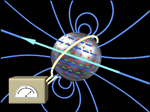WEEKLY HIGHLIGHTS FOR 24 SEPTEMBER 2004:
GRAVITY PROBE B MISSION UPDATE
GP-B had an eventful week. We began the 4th week of science with all four gyroscopes in the science mode. Then on Thursday we had an anomaly with gyro #3.
At 830 PM local time on Thursday, the drag-free gyro #3 transitioned to analog mode resulting in safemode that stopped the timeline. The GP-B vehicle and science gyros were safe. Gyro's #1, #2 and #4 remained in the digital suspension science mode. A preliminary assessment by the science team indicated minimal impact to any experiment accuracy. An investigation is under way to determine the cause of the drag-free gyro #3 transition to analog mode and safemode activation. The operations and engineering teams did an excellent job working through the night to safe the vehicle and quickly develop a recovery plan.
By Friday afternoon the spacecraft was back in science collecting mode with gyro #1 performing the drag free operation. On Saturday the operations team successfully transitioned Gyro #3 from analog suspension to the digital suspension science mode. All other spacecraft systems are in excellent health. The spacecraft is rolling at a rate of 0.775 rpm (one revolution every 77.5 seconds). The Attitude and Translation Control (ATC) system is maintaining a drag-free orbit around gyro #1, and it is properly tracking the guide star, IM Pegasi. The Dewar temperature is nominal (1.82 Kelvin), and the flow of helium, venting from the Dewar through the micro thrusters has remained within expected limits.
During the week the team performed a heat pulse test on the spacecraft Dewar to obtain further information to help predict lifetime. Early indications are that the helium in the Dewar will last another 10 months, which should be sufficient to satisfy the mission requirements.
 -->
-->
SWISS AMATEUR ASTRONOMER PHOTOGRAPHS GP-B GP-B SPACECRAFT IN ORBIT WITH GUIDE STAR IM PEGASI
To the right, is a thumbnail of a photograph of the GP-B spacecraft in orbit, along with the guide star, IM Pegasi. (Click on the thumbnail to view the photo at full size.) The photo was taken and emailed to us by Stefano Sposetti, a Swiss physics teacher and amateur astronomer. Stefano used a 40cm newtonian telescope, with a CCD camera and 20mm wide field lens attached to make this photo. He then sent us the two versions shown — the normal (black sky) version on the right, and an inverse version in which the constellation, Pegasus, the guide star IM Pegasi, and the path of the GP-B spacecraft are highlighted for easy identification on the left.

We are grateful to Stefano for sending us this wonderful photo. You can view other astronomical photos that he has taken on his Web page: http://aida.astronomie.info/sposetti. Following is Stefano's description of his photo:
In this picture one can see the quite dim GP-B satellite traveling from North (up) to South (down) direction. The bold line in the right part of the left image represents the satellite trail just before entering the earth shadow. (Every satellite becomes visible because it reflects the sunlight). The connecting lines show the constellation Pegasus. The small circle around the star is IM Pegasi, the guide star used by the spacecraft's telescope in his experiment! GP-B is a circumpolar satellite following a free fall trajectory about 640km above the earth surface. From my location the satellite passed that night at a maximum elevation of 87degrees, thus not exactly overhead. The brightness of the satellite was between 3mag and 4mag. The Moon, about in the last quarter phase, illuminated the sky and was a drawback for having a good signal/noise ratio of the satellite trace. I took this 60-seconds black and white CCD picture with a 20mm,f/2.8 lens on august 6 centered at 01:19:00 UT. North is up, East is left.
More links on recent topics
- Track the satellite in the sky
- Photo, video & and news links
- Build a paper model of the GP-B Spacecraft
- Following the mission online
- Our mailing list - receive the weekly highlights via email
- The GP-B Launch Companion in Adobe Acrobat PDF format. Please note: this file is 1.6 MB, so it may take awhile to download if you have a slow Internet connection.
Previous Highlight
Index of Highlights
